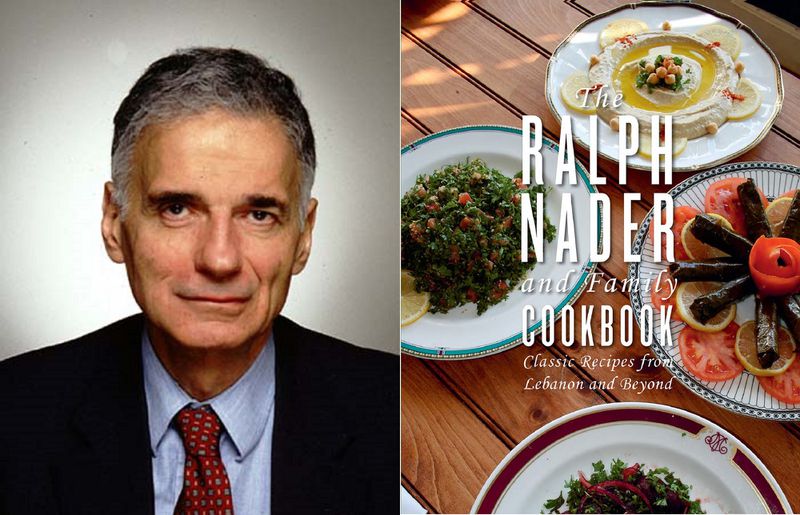By SUSAN DUNNE

Ralph Nader, the famed consumer advocate, attorney, author, museum owner and presidential candidate from Winsted, has added another category to his resume: foodie.
Nader, 86, has published “The Ralph Nader and Family Cookbook” . The book is both a compilation of Lebanese dishes Nader grew up eating and an homage to his mother Rose, who never let her children eat anything processed or prepackaged, and always cooked from scratch.
“Never would hot dogs cross our plates, much less bologna or Spam. She would explain, ‘I don’t know what is in those hot dogs, and I don’t trust something I don’t know about’,” Nader writes in the book.
Nader said when he was growing up in Winsted, his mother and his father, Nathra, used meal times as educational experiences for him and his brother, Shafeek, and sisters, Laura and Claire.
“It was a way, first, to get our attention, because we were hungry,” Nader said in a phone interview from his home in Winsted. “But then she used food as a teaching opportunity, about the history of the food, the farmers who made it, the nutrition. … She wanted us to converse, not to gobble.”

While it may seem a cookbook is a digression from Nader’s usual focus on safeguarding consumers from harm, the inspiration for the book is related to that work.
“I was working on advocacy in the ’50s, ’60s, ’70s, for food labeling laws, and I would often be asked, ‘well, what do YOU eat?’” Nader said in a phone interview from his home in Winsted. “I would mumble something about my mother’s recipes, and they wouldn’t know what I was talking about.”
Lebanese ingredients
Some of Nader’s dishes – hummus, tabouleh, yogurt – and ingredients – Swiss chard, bulghur wheat, tamari sauce – are familiar to today’s consumers. But when Nader was growing up in the 1930s and ’40s, and even when he was a young adult, nobody had heard of his mother’s traditional Lebanese dishes.
Other ingredients, such as mahlab and orange blossom water, remain obscure to the everyday shopper. Nader said he has no trouble finding all his ingredients at co-ops, health food stores and supermarkets.
The book is full of ingredients known to anyone familiar with Mediterranean diets: chickpeas, lemons, eggplants, ground lamb, lentils, tomatoes, olive oil, pine nuts, grape leaves, semolina.
Rose Nader’s attitude toward food, as he writes in his book, is the opposite of parents who want their kids to approve of what they eat.
“Young children don’t know what is good for them,” he quotes her as saying. “They don’t have to like what they eat; they just have to eat it.”
And he and his siblings did eat it, every bite, every day and night, and grew to love it.
Nader said his mother referred to her recipes as “use your own judgment recipes,” because she wanted people to adjust the ingredients to their own tastes.
Two of the recipes in the book were contributed by George Noujaim, who runs Noujaim’s Bistro in Winsted. Noujaim’s recipes are a garlic soup, which uses 52 garlic cloves, and Mediterranean eggplant.
Nader’s favorite recipe is Sheikh Al-Mahshi, baked eggplant stuffed with lamb and pine nuts, which also can be made meat-free. “She made it on my birthdays,” he said.
While many of Nader’s book-speaking engagements have been canceled due to the coronavirus pandemic, Nader considers the April publication of the book to be perfect timing.
“People are home all the time. They are spending more time in the kitchen, cooking for themselves, starting backyard gardens to grow their own food, re-introducing themselves to their children,” he said. “This is a way to elevate a bad diet to a nutritious diet that it turns out is delicious.”
Poor diets always have been a concern for Nader, and COVID-19 has heightened his concern.
“People are eating diets loaded with fat, sugar and salt. These terrible chains, McDonald’s and others, they’ve done so much to kids to destroy their health,” he said. “This leads to obesity, diabetes, high blood pressure. People with better diets are more resistant if they come down with the virus.”
New projects
Other aspects of the pandemic have him concerned, too, inspiring him to go back to his consumer advocacy work on a new project he and his associates are working on.
“Trump is trying to give immunity to corporations who are producing drugs to deal with the pandemic. Think of all the products out there. Without tort law accountability, a lot of people will be hurt,” he said.
Another new consumer-protection project he is working on is rooted in personal grief. He lost a grandniece, Samya Stumo, in the March 2019 crash of an Ethiopian Airlines Boeing 737 MAX 8. She was among 157 people killed.
“She was an emerging leader in global health in Africa. I guess we’ll never know how many people she saved,” Nader said. “The families have organized marvelously to try not to let the FAA fly that plane again.”
A few months earlier the same make and model of plane crashed in Indonesia, killing 189 people. In both crashes, the plane’s flight-control system became the focus of inquiry.
If pressure on the FAA doesn’t work, Nader is encouraging a consumer boycott of that plane, which he would call “Ax and MAX.”
“The Boeing 737 MAX is the latest iteration of a plane that has not been redesigned since the 1960s,” he said. “They installed new software which made the pilots not know what was going on, like some hidden hand came in and took control of the plane.”
Details about all of Nader’s current work, and virtual tours of the exhibits in his American Museum of Tort Law in Winsted, can be found at nader.org.
Recipes

Tabouleh
Ingredients
- 3 bunches parsley
- 4 sprigs fresh mint
- 1 cup fine burghul (bulghur wheat)
- 2-3 bunches scallions, minced
- 5 tomatoes, 3 minced and 2 thinly sliced
- juice of 8 lemons, or to taste
- 1/2 cup olive oil, or to taste
- salt and pepper to taste
1 head romaine lettuce, or more if needed
Directions
Tear parsley florets off the stems. Pick mint leaves off the stems. Rinse the parsley and mint. Mince the parsley very fine and cut the mint into small pieces.
Wash burghul and soak in water for 5-7 minutes. Squeeze the water out and add to the above.
Add scalllions, minced tomatoes and lemon juice until a tart taste has been achieved. Add olive oil to taste.
Season with salt and pepper.
Wash lettuce and separate the leaves. Drain well. Place some of the lettuce leaves on a serving platter and put the tabouleh over it. Decorate the top with thin tomato slices and small pieces of lettuce all the way around the platter so that these can be included with each serving.

Hummus bi Tahini
Ingredients
- 1/2 pound dried, uncooked chickpeas or 3 cups of cooked chickpeas
- 6 cups cold water
- 4 garlic cloves
- 1 teaspoon salt
- 1 teaspoon cumin to taste (optional)
- juice of 2-3 lemons
- 5 generous tablespoons tahini
- 2 tablespoons olive oil
- 1 teaspoon paprika (optional)
- 4-5 sprigs parsley
Directions
For dried chickpeas: Soak the chickpeas overnight in cold water after removing any small stones or blemished chickpeas. The next day, wash the chickpeas well, rinsing them several times.
Keep up with news from the Connecticut food scene, delicious recipes, and restaurant and bar reviews
For canned chickpeas: drain and rinse.
Put chickpeas in a pot with 6 cups of cold water and bring to a boil. Lower heat and simmer for roughly 1 hour. Tilt the cover of the pot so there is a way for the steam to escape, keeping the foam under control. The chickpeas are done when a pea can be mashed easily between two fingers.
Serve on a platter chilled or at room temperature. Drizzle olive oil over the top. If you wish, you can sprinkle paprika over the hummus for color. Garnish with sprigs of parsley.
Susan Dunne can be reached at sdunne@courant.com
Source: HARTFORD COURANT

Leave a Reply
You must be logged in to post a comment.